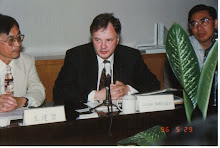OLPC unveils slimline tablet PC
By Jonathan Fildes
Technology reporter, BBC News
OLPC XO-3
In Pictures: Designing the OLPC
The group behind the $100 laptop has revealed the design for its latest computer aimed at connecting children in the developing world.
The XO-3, as it is known, is a slim-line touchscreen tablet PC.
One Laptop per Child (OLPC) said it would be "available in 2012" and would cost "well below $100".
The new design replaces the proposed XO-2, a foldable e-book that was first shown off in 2008 but has since been scrapped by the organisation.
The XO-3 will eventually replace the original XO laptop that first went into production in 2007.
The innovative machines, which have been designed for use in remote and harsh environments, were designed for use by school children and featured a sunlight readable display and open source software.
'Bigger appeal'
OLPC originally aimed to sell the low-cost laptops in lots of one million to governments in developing countries for $100 each.
However, the non-profit organisation had difficulty getting governments to commit to bulk orders. The machines - which are able to run both Linux and Microsoft Windows - are now offered in single units and cost around $200.
the new xo-s laptop
The XO-2 has been scrapped in favour of the XO-3
So far the XO has been distributed to more than 1.4 million children in 35 countries.
The high-price has not however put off all governments. Uruguay has bought a computer for every one of their school children.
Walter de Brouwer, CEO of OLPC Europe said that these "saturation projects" were the future of the organisation both in the developed and the developing world.
"I'm talking to three four countries in the EU at the moment," he told BBC News. "Once one says yes, the others can't say no."
The organisation believes the new design will cost significantly less.
Mr Brouwer said that because of the pace of technological change and the ever decreasing prices of electronics he could imagine the design selling for "50, 60 or 70 euros".
He said governments could pay this back over a number of years, allowing pupils to have a laptop for less than one euro per month.
"This is very realistic," he said.
The concept shows a touchscreen, a camera, induction charger, and a carrying ring on one of its corners.
Its inner workings - including a chip from UK firm ARM - will come from an interim design - the XO 1.75 - set for launch in 2011.
The 1.75 will merge elements of the current machines with technologies - such as a touchscreen - intended to be included in the XO-3.
OLPC recently said that the organisation would just focus on promoting its concepts and educational aims, rather than manufacturing laptops.
"We are not a laptop company," said Mr Brouwer. "Manufacturing a laptop is not such a big deal. The bigger appeal for us is deploying them and integrating them with education systems to transform a society."
Nicholas Negroponte, founder and chairman of the group, said that he hoped that industry would now copy the design for the XO-3.
Sunday, December 27, 2009
Subscribe to:
Post Comments (Atom)




No comments:
Post a Comment